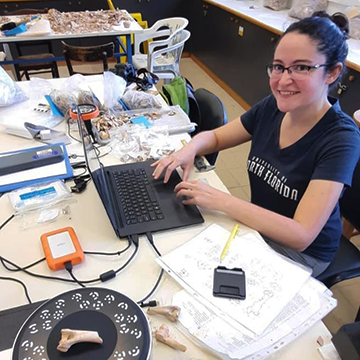UNF archaeologist and team identify earliest known example of fossil collecting in Greece
 Dr. Jacqueline Meier, assistant professor of anthropology at the University of North Florida, is the co-author of a groundbreaking paper describing a curious archaeological find of a bone believed to be the earliest known example of fossil collecting in ancient mainland Greece.
Dr. Jacqueline Meier, assistant professor of anthropology at the University of North Florida, is the co-author of a groundbreaking paper describing a curious archaeological find of a bone believed to be the earliest known example of fossil collecting in ancient mainland Greece.
The team rediscovered an object at the Archaeological Museum of Mycenae in Greece in collections that were originally excavated in the 1970s and identified the object as a fossilized astragalus (ankle bone) of a genus of rhinoceros. This animal was extinct in the time of the Mycenaeans who would have collected the bone. The study highlights the fossil’s significant implications for understanding Greek culture during the Bronze Age.
The fossil was found in a storage area alongside a range of artifacts, including worked shells, indicating it was not merely discarded but possibly held ritual or symbolic significance. Though the fossil’s use in the Late Bronze Age is uncertain, Meier and an international team of archeologists suggest it could have been used as gaming equipment, a zoomorphic weight or an apotropaic or ritual item.
 The bone was found in an undisturbed layer of ground dating from 1230 to 1200 BCE, indicating that this is the earliest known example of fossil collecting in mainland Greece. Later Greek myths of the giants, like Cyclopes, were likely influenced by fossils that were already ancient objects to people who saw them in the past. The work by Dr. Meier and her co-authors shows that collecting fossils from large extinct animals was already occurring in Greece much earlier during the Bronze Age.
The bone was found in an undisturbed layer of ground dating from 1230 to 1200 BCE, indicating that this is the earliest known example of fossil collecting in mainland Greece. Later Greek myths of the giants, like Cyclopes, were likely influenced by fossils that were already ancient objects to people who saw them in the past. The work by Dr. Meier and her co-authors shows that collecting fossils from large extinct animals was already occurring in Greece much earlier during the Bronze Age.
Meier’s fellow co-authors in the research include Dr. Vassiliki Pliatsika, archeologist at the Hellenic Ministry of Culture, and Dr. Kim Shelton, professor of Ancient Greek and Roman Studies at the University of California Berkeley.
Their work adds to the growing body of evidence that ancient cultures across the Mediterranean engaged in the symbolic use of ancient animal remains, revealing a shared fascination with fossils that transcended cultural boundaries.
Read “The earliest evidence of large animal fossil collecting in mainland Greece at Bronze Age Mycenae” in Scientific Reports.
